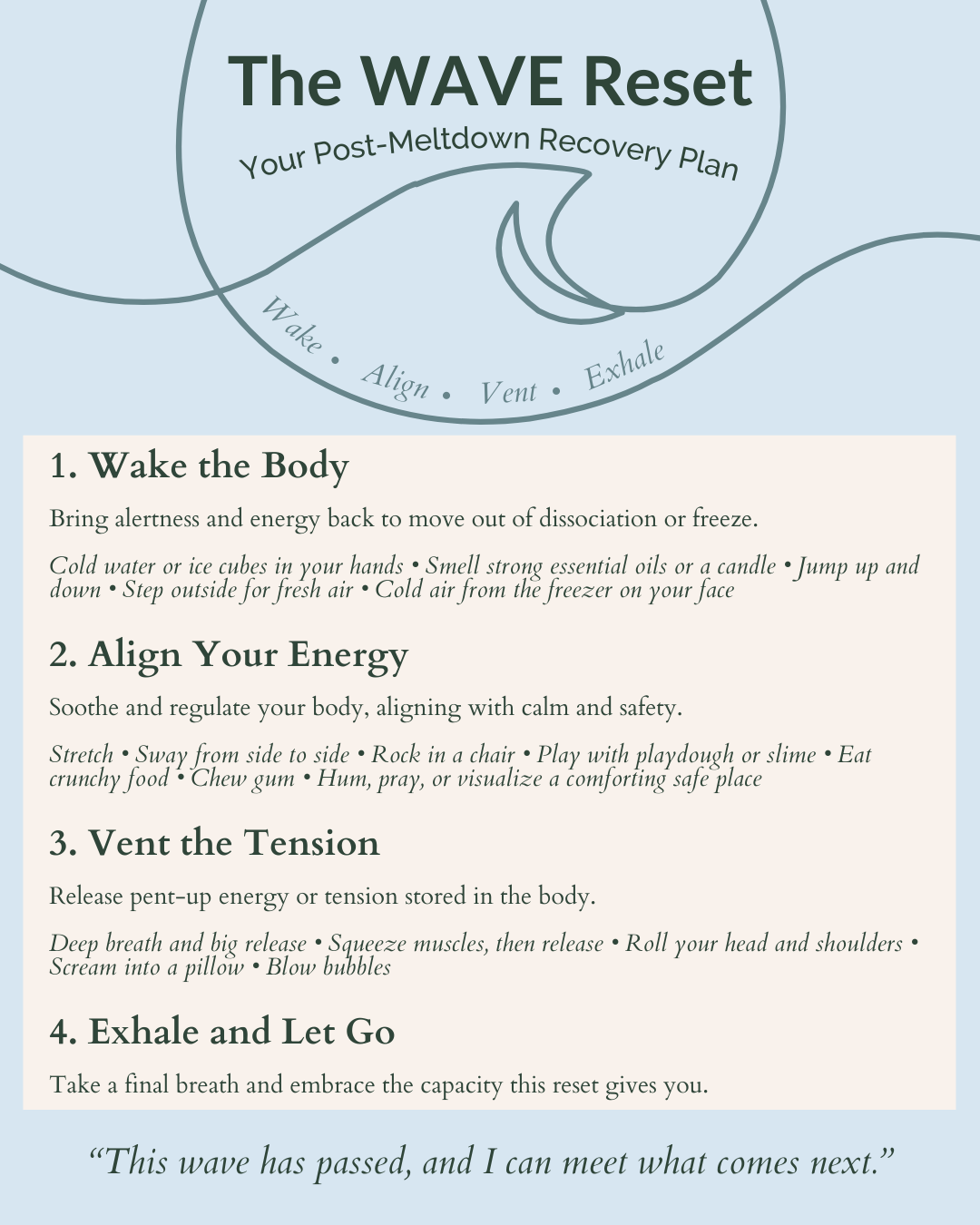“Toxic Calm”: Why trying to be calm is killing us and what actually helps in meltdowns
Mar 21, 2025
For years, I thought my parenting job—especially when my kid was melting down—was to stay calm. Calm was the goal. Calm meant I was doing it right.
And I could do calm. Sort of.
I could look calm while my insides were a storm. I could sound calm while my body quietly slipped into freeze. I could perform calm while my brain floated ten feet outside my body, watching from a distance.
I learned the hard way that that’s not calm. That’s dissociation—and it’s a trauma response.
Calm is overrated. What we actually need—in ourselves and in our kids—is a way to move through our feelings instead of locking them inside our bodies. We need to complete the stress cycle, not get stuck in what Emily and Amelia Nagoski call “the tunnel” in their book Burnout.
Dissociation is one way to survive the tunnel, but it’s not the same as getting out.
Are You Dissociating and Calling It “Calm”?
If you’re wondering if dissociation has been playing a role in your parenting (especially during your child’s hardest moments), here’s a quick check-in list:
- Do you feel numb or detached, even while actively parenting?
- Does your brain go foggy, and you lose track of what’s happening?
- Do you feel like you’re “watching” yourself parent, instead of actually being present?
- Do you hear yourself saying “It’s fine” when it’s absolutely not fine?
- Do you freeze—physically or emotionally—when your child escalates?
This is your nervous system protecting you, trying to help you survive a moment that feels overwhelming. It makes sense. But over time, dissociation can block the healing you (and your child) need.
What Burnout Teaches Us About Stuck Stress
In the book Burnout, the Nagoski sisters remind us that feelings live in the body—not just in the mind. Stress is a physiological event. It floods your bloodstream with hormones. It tightens muscles. It changes how you breathe and digest and think.
Stress isn’t over when the trigger is gone. Stress is over when your body gets the message that you’re safe.
If we “calm down” by dissociating—shoving those feelings deep inside—we never finish the stress cycle. The stress stays trapped in our bodies, like a closed loop with no exit.
Our kids experience the same thing. When we focus on getting them calm instead of helping them complete the stress cycle, we unintentionally teach them to bypass their feelings. The meltdown might end faster—but the stress stays put, waiting to surface again.
So What’s the Goal Instead of Calm?
When your child melts down, your goal isn’t to create a calm house. Your goal is to create a house where feelings can move. Where stress cycles complete. Where nervous systems trust they are safe—even when the air is thick with big feelings.
The opposite of dissociation isn’t calm—it’s presence.
Presence says: I’m here. I’m in my body. I can feel this. I can stay.
Presence says: Your feelings don’t scare me. My feelings don’t scare me.
Presence says: We can move through this together.
Enter: The WAVE Reset
This is where The WAVE Reset comes in—a simple, practical way to complete the stress cycle in your own body after a meltdown (yours or your child’s). This isn’t about talking yourself into calm. It’s about physically shaking off the storm and resetting your nervous system.

Here’s how the WAVE Reset works:
W - Wake the Body
Come back into sensation—remind your body you are alive and safe.
- Cold water on your face
- Step outside for fresh air
- Hold an ice cube in your hand
- Smell something strong (peppermint oil, candle)
- Jump up and down
A - Align Your Energy
Help your body shift from threat to safety.
- Rock in a chair or sway side to side
- Chew crunchy food or gum
- Play with something sensory (slime, Play-Doh)
- Hum, pray, or visualize your safe place
V - Vent the Tension
Physically release the energy still stuck in your system.
- Take a deep breath and sigh it out
- Squeeze your fists and release
- Scream into a pillow
- Blow bubbles or sing loudly
- Squeeze and hold your muscles and then release
- Shake everything in your body for 60 seconds
E - Exhale and Let Go
Offer yourself a final moment to mark the wave’s passing.
- Whisper: “That was a lot, but I’m still here.”
- Place a hand on your heart and take one last breath.
Reflection: Is Dissociation Serving You Right Now?
This isn’t about blaming yourself for dissociating. If you’ve been using it to survive, that’s evidence of your strength, not failure. But the question now is: Do I still need it?
Some reflection prompts to explore:
- When do I notice myself checking out?
- What feelings am I avoiding when I leave my body?
- What might shift if I stayed present for just 10 more seconds?
- How could I offer my body more care and safety, so I don’t have to dissociate as much?
The Real Gift is Presence
Your kids don’t need a perfectly calm parent. They need a present parent.
A parent who can say:
- “I’m feeling overwhelmed right now.”
- “This is really hard for both of us.”
- “I’m going to take a minute to shake this off.”
- “I’m still here with you.”
Calm is overrated. Presence is what heals. And presence starts with you, coming home to your body, one WAVE at a time.
Want to print out the WAVE Reset for your fridge or journal? Save the image or screenshot for the next meltdown. You’re not alone in learning how to move through the hard moments.
Quiz: "Why is everything so hard?"
................
Get your quiz results and discover one concrete next low-demand step toward ease and joy.
Low Demand in your Inbox
Juicy weekly emails include real-life parenting stories, low-demand ideas and tips, plus a collection of my favorite resources. A goodie-box of an email.
We hate SPAM. We will never sell your information, for any reason.

